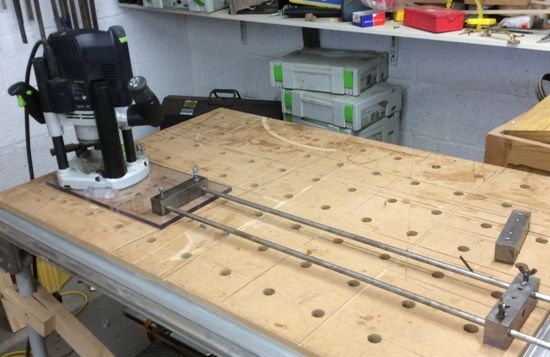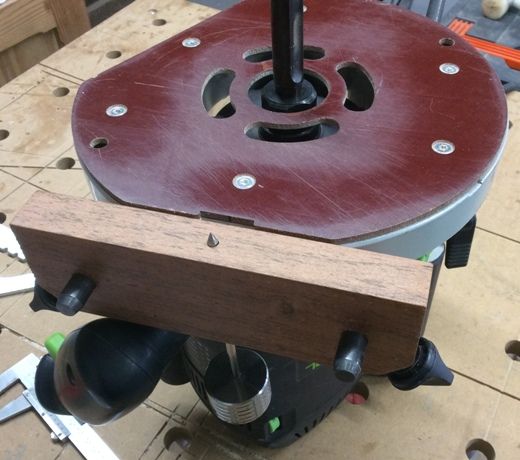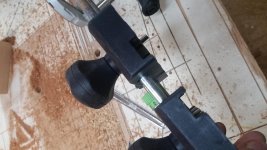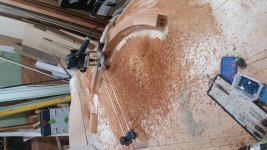Rob-GB
Member
- Joined
- Nov 7, 2009
- Messages
- 1,101
Many years ago I had to route an 8 metre radiused pattern piece for a wood framed free standing partition for an office in London, it took many lengths of mdf strips screwed together and the car park to accomplish. After that I asked my brother who had his own toolmaking shop to make some blocks and connecting bars to swing up to a 3 metre radius as I doubted I would ever need anything so big again and with cad and cnc being more easily available now there would be no need.
My problem was that the setup was designed around the old Elu 177e and fortunately suited the Dewalt version so all was well until I got my OF2200.
While the bars are all 10mm the centres are off so I sorted a workaround:-

The Perspex plate allowed me to join the OF2200 to the old jig parts or by drilling it for the 5mm pins I stole from some kitchen shelf pegs use the plate itself.


The little perspex part next to the router base is a storage compartment for spare pins and to the right are two tapped holes to store the screws that connect the plate to the router.
This was all well and good until I did not have the base plate with me on a job (it is sized to fit in a systainer but resides in the shop)
so I thought about another get around for one that can live in my router's systainer...

Made from what was Rhodesian Teak flooring 20mm thick and using 4mm, 5mm and 10mm centrotec dowel point bits in my pillar drill and a 6mm taper tap and a strip of 320 grit paper to clean up/ease the 10mm holes for the rods (they are a bit tight and engineers use tolerances for fit).

With the OF2200 plunged at max depth and the bar on the flat side the centre of pin to centre of router bit is 102mm and it just clears the handle and the max using the routers bars is 410mm cntr to cntr. Of course with my 6 one metre bars I can swing a bigger arc.
Even with a twin bar setup there can be detrimental flexing in the bars which is why I had three blocks made originally and these proved useful on all but the greatest arcs when some surreptitious use of mdf strips and masking tape stabilised the bars nicely.
I chose to angle the knobs to get more strength from the timber grain structure, end grain is a poor screw thread retainer and placing the knob on top would clash with the handles on the router. The Knobs are a couple of Festool spares I purchased as a "just in case" and to make up the free postage on an order a couple of years back.
If anyone is interested here is a PDF at 1:1 scale of the wooden part.
Rob.
My problem was that the setup was designed around the old Elu 177e and fortunately suited the Dewalt version so all was well until I got my OF2200.
While the bars are all 10mm the centres are off so I sorted a workaround:-

The Perspex plate allowed me to join the OF2200 to the old jig parts or by drilling it for the 5mm pins I stole from some kitchen shelf pegs use the plate itself.


The little perspex part next to the router base is a storage compartment for spare pins and to the right are two tapped holes to store the screws that connect the plate to the router.
This was all well and good until I did not have the base plate with me on a job (it is sized to fit in a systainer but resides in the shop)
so I thought about another get around for one that can live in my router's systainer...

Made from what was Rhodesian Teak flooring 20mm thick and using 4mm, 5mm and 10mm centrotec dowel point bits in my pillar drill and a 6mm taper tap and a strip of 320 grit paper to clean up/ease the 10mm holes for the rods (they are a bit tight and engineers use tolerances for fit).

With the OF2200 plunged at max depth and the bar on the flat side the centre of pin to centre of router bit is 102mm and it just clears the handle and the max using the routers bars is 410mm cntr to cntr. Of course with my 6 one metre bars I can swing a bigger arc.
Even with a twin bar setup there can be detrimental flexing in the bars which is why I had three blocks made originally and these proved useful on all but the greatest arcs when some surreptitious use of mdf strips and masking tape stabilised the bars nicely.
I chose to angle the knobs to get more strength from the timber grain structure, end grain is a poor screw thread retainer and placing the knob on top would clash with the handles on the router. The Knobs are a couple of Festool spares I purchased as a "just in case" and to make up the free postage on an order a couple of years back.
If anyone is interested here is a PDF at 1:1 scale of the wooden part.
Rob.


